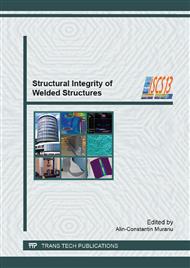p.60
p.68
p.76
p.82
p.87
p.99
p.104
p.110
p.115
Determination and Analysis of the Dynamic Loaded Screws by Structural Analysis, Fractography and Numerical Simulation
Abstract:
This paper analysis the causes dynamically loaded screws failure, using the structural analysis of mechanical properties and numerical simulation. The comparison with the new unbroken screws, which were not in use, has been done to determine the condition of the broken (dynamically loaded) ones. Analysis was performed, according to the following test methods and activities: non-destructive testing, visual inspection, radiographic testing, chemical analysis of screws sample materials, mechanical properties of screws' materials. Structure analysis of screws materials: Testing macrostructure (light optical microscope, SEM-EDS) examination of the microstructure (light optical microscope, SEM-EDS), fractographic examination. Numerical simulation of the stress state of the dynamically loaded screws was done in CATIA software package, and it was identical to the bolt loads, during service exploitation. The results between numerical simulation and structural analysis were quite coinciding - the difference is about 8-10%, which is pretty good for these types of experiments. Such an overlap, says that the stress value at the very screws is reliable and give us a true picture of loadings. Structural mechanical tests have shown a very pronounced effect of dynamic loads, that large shear stress shows also as a good agreement, where between the stresses, obtained by numerical simulation and structural mechanical testing. Analysing the results, obtained by numerical simulation and structural mechanical testing were performed with the redistribution of critical stresses, and proposal for the structure optimization. The comparative analysis methods have been provided the precise prediction of fracture appearance and made possible to define the preventive measures.
Info:
Periodical:
Pages:
87-98
Citation:
Online since:
September 2013
Authors:
Price:
Сopyright:
© 2013 Trans Tech Publications Ltd. All Rights Reserved
Share:
Citation:


